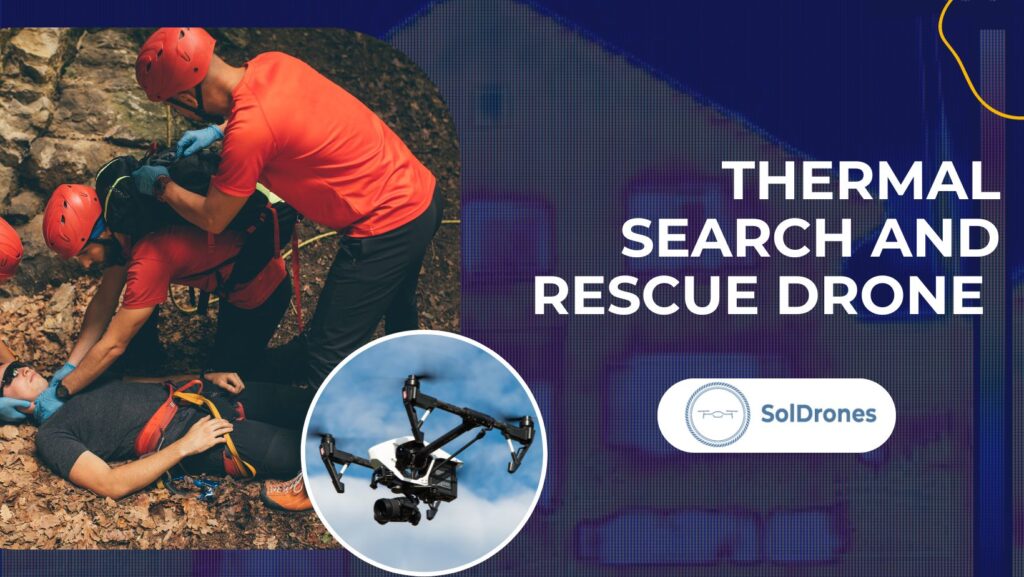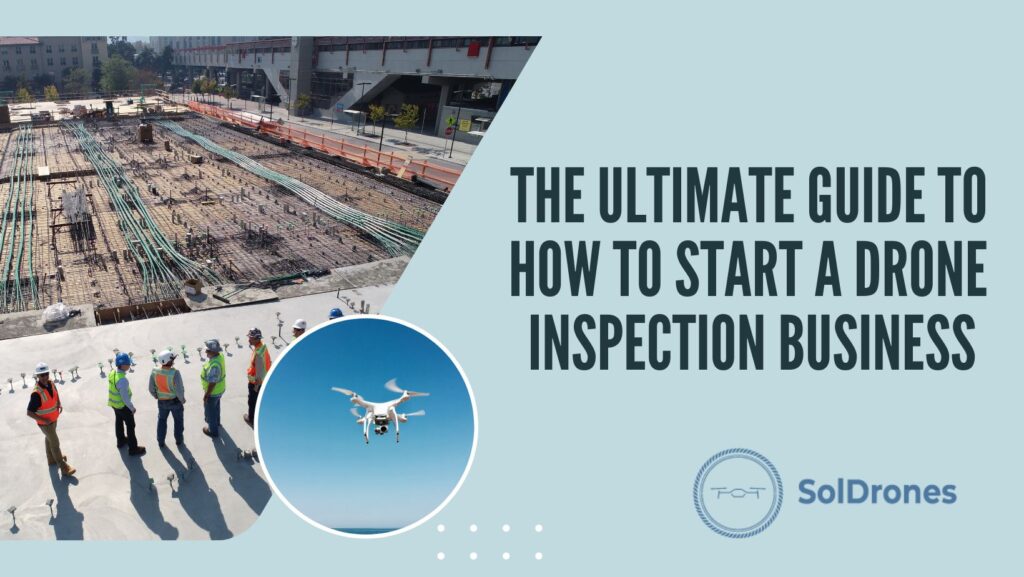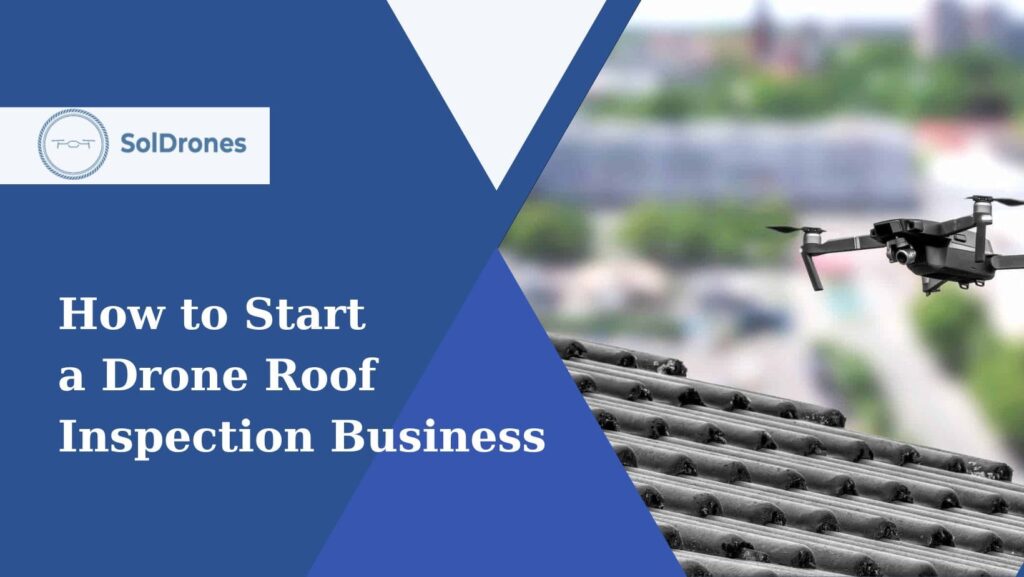Thermal Search and Rescue Drones are game-changers in finding missing people, even in the toughest spots.
Using advanced thermal imaging, these drones quickly spot people by their body heat, making rescues faster and safer. With time being crucial in rescues, these drones are making a real difference, reuniting families and saving lives.
In this article, we overview how thermal imagery drones are being used in search and rescue missions, their advantages and challenges, and how this is quickly becoming a niche for drone pilots to help the greater good of society.
If you’re in the process of shopping around for a thermal imaging drone, check out our other recent article on the Best Thermal Imagery Drones, where we review top models such as the DJI Mavic 2 Enterprise Advanced.
Article Highlights:
- Thermal drones bring unparalleled precision and real-time situational awareness to search and rescue missions.
- The versatility of thermal drones is evident as they transform operations in various sectors beyond rescue missions.
- Technological advances in thermal drones are enhancing capabilities, including advanced sensors and improved communication.
The Essence of Thermal SAR Drone
Definition of Thermal Drones
Thermal drones are specialized types of drones equipped with thermal cameras designed to detect heat emitted by living beings.
In a world where every second counts, the relevance of a search and rescue drone is paramount.
These are invaluable in search and rescue missions, particularly during night operations when visibility is low and finding a missing person in vast areas becomes significantly challenging.
Video Credit: Wogen
Purpose and importance in Search and Rescue Operations
Thermal Search and Rescue Drone is critical in enhancing search and rescue teams’ efficiency and success rate. Their primary purpose is to quickly and accurately locate distressed individuals, providing real-time data and situational awareness that guide rescue crews in their mission. The importance of these drones is profound, especially in challenging environments and conditions where every second counts. They optimize the speed and efficacy of search and rescue operations, ensuring that help is dispatched promptly to those in need.
How thermal imaging technology aids in detecting living beings during search and rescue missions
Thermal imaging technology serves as the backbone for the effectiveness of thermal drones. This sophisticated technology, facilitated by a thermal sensor, is critical for detecting heat signatures from living beings or also known as body heat, making it indispensable in search and rescue missions.
Through the drone’s video feed, this technology grants rescue teams the ability to accurately locate missing people even in areas plagued with poor visibility or obstructive elements, a crucial capability during urban search and night operations.
The deployment of a quickly deployable drone equipped with thermal imaging can significantly enhance situational awareness for ground teams, providing them with precise location data and allowing them to deliver emergency supplies more efficiently.
Such enhanced accuracy and capability empower search and rescue teams to plan and implement their rescue operations more proficiently.
Commercial drones equipped with advanced thermal imaging facilitate a higher likelihood of mission success, ensuring that life-saving interventions are more effective and reliable.
Advantages of Thermal Drones in SAR Operations
Thermal Drones in SAR (Search and Rescue) operations and the Federal Aviation Administration (FAA) are reshaping the paradigms of emergency response, bringing forth unparalleled advantages crucial for rescue missions’ success. Below, we delve into the significant benefits SAR drones offer:
1) Enhanced Detection Capabilities
SAR drones equip emergency responders with advanced technologies that ensure enhanced detection capabilities, allowing them to locate individuals in distress more efficiently. The sophisticated sensors on these drones can discern heat signatures from a distance, providing accurate location data to the ground crew, which is pivotal for coordinating effective rescue efforts.
2) Time Efficiency and Rapid Response during SAR Operations
Time is of the essence in any rescue operation. SAR drones save valuable time, enabling quick assessments of large areas and helping rapidly deploy emergency services. The information the drones relay allows for swift, informed decisions, significantly reducing the response time and increasing the chances of a successful rescue.
3) Access to Remote and Inaccessible Areas
One of the notable advantages of drones for SAR teams is their ability to traverse and access remote and otherwise inaccessible areas. They can maneuver through tight spaces, rugged terrains, and hazardous environments where a ground team might be difficult and risky to reach. This capability ensures that the drones can extend help to the most secluded areas, widening the reach of rescue efforts.
4) Enhanced Safety for Rescue Teams
Ensuring the aircraft safely navigates through the skies, SAR drones offer rescue teams an extra layer of safety. By providing critical situational awareness and real-time data, drones allow emergency responders and ground crews to assess risks better and approach situations with enhanced precaution, thereby minimizing the potential dangers the ground crew faces during rescue operations.
Overview Challenges
Thermal drones, or Unmanned Aerial Vehicles (UAVs), encounter many challenges in varying environments, particularly during a rescue mission. Some of these challenges include:
- Varied Terrain: Different terrains present unique challenges in maneuvering and maintaining aircraft safely, affecting the drone search capabilities.
- Weather Conditions: Adverse weather can impact the functionality and efficiency of thermal drones, posing potential risks to emergency responders.
- Signal Interference: Maintaining stable communication between the ground crew and the drone can be challenging in areas with high electromagnetic interference.
- Limited Battery Life: The endurance of thermal drones is often constrained by their battery life, which can impede prolonged search and rescue missions.
- Visibility Issues: During night operations, even with thermal imaging, discerning between visible light and thermal signatures can be difficult, affecting rescue efforts.
Solutions & Research
To overcome the aforementioned challenges, several solutions and research initiatives are underway:
- Advanced Sensor Technology: Enhancements in sensor technology aim to improve detection capabilities in diverse conditions, aiding emergency responders in a search and rescue mission.
- Improved Battery Solutions: Research is focused on developing batteries with longer life and faster charging capabilities to save valuable time during critical rescue missions.
- Enhanced Communication Devices Systems: Solutions are being developed to bolster communication between drones and ground crew, ensuring stable connectivity even in areas with high interference.
- Intelligent Navigation Systems: Ongoing research aims to equip thermal drones with smarter navigation systems to guide rescue crews efficiently through varied terrains and conditions.
Drone Tech Advancements
The advancements in UAV technology are pivotal for the enhanced efficacy and reliability of rescue drones search in various environments:
- AI and Machine Learning: Incorporating AI and machine learning enables drones to process and analyze data faster and more accurately, offering invaluable support to search and rescue teams.
- Robust Design Enhancements: Structural design developments contribute to more durable and resilient drones, capable of withstanding harsh conditions and ensuring aircraft safely operate in diverse settings.
- Enhanced Thermal Imaging: Ongoing improvements in thermal imaging technology are critical for enhanced detection during night operations, enabling drones to offer rescue teams more precise and reliable data in emergency response scenarios.
Real-world Drone Rescue Stories
Thermal drones have played significant roles in many rescue missions, but one instance stands out in showcasing their potential. In the United States, a thermal drone was crucial in locating and rescuing a missing 6-year-old boy and his dog in a wooded area in Missouri.
The ground search became increasingly difficult as darkness fell and visibility was reduced to almost zero. The thermal drone, however, could detect the heat signatures of the boy and his dog, leading the rescue team directly to their location and ensuring their safe return.
This mission underscored the vital capabilities of thermal drones in locating missing persons swiftly and safely, even under the most challenging conditions.
Insights and testimonials from rescue teams and beneficiaries
The feedback and insights from the rescue teams and the beneficiaries involved in such missions provide a deeper understanding of the significance of thermal drones in real-world search and rescue operations.
Rescue teams have commended thermal drones’ enhanced visibility, precision, and ability to access remote and difficult terrains, emphasizing how these capabilities are indispensable during night operations or in environments with poor visibility.
On the other hand, beneficiaries express immense gratitude and relief, attributing their survival and safe return to the timely intervention facilitated by thermal drones. These heartfelt testimonials and insights underscore the transformative impact and the life-saving potential of thermal drones in search and rescue missions, advocating for their wider adoption and continual development in rescue operation.
This real-world success story is illustrative of the myriad ways in which thermal drones have been pivotal, demonstrating their life-saving impacts and technological advancements in actual search and rescue scenarios.
Upcoming Trends in Thermal Search and Rescue Drones
In this section, we will explore future advancements, emerging technologies, and the prospective evolution of thermal drones. The continuous innovation in this field is set to redefine the norms of search and rescue operation, furthering the scope and efficiency of emergency response strategies.
Emerging technologies and their implications for the future of thermal drones
Emerging technologies are set to revolutionize the capabilities of thermal drones in search and rescue missions.
Developments such as enhanced thermal imaging, AI integration, and advanced sensor technology are poised to significantly increase thermal drones’ efficiency, accuracy, and range.
These innovations will enable thermal drones to detect more subtle temperature differences, navigate more complex environments, and analyze data more accurately, allowing quicker and more effective emergency response.
The potential evolution of thermal drone capabilities
The continual evolution of thermal drone technology hints at an exciting future, with drones becoming more autonomous, intelligent, and versatile. We can expect advancements in battery life, flight range, and payload capacity, allowing drones to operate for extended periods and cover larger areas.
Additionally, integrating advanced AI and machine learning will empower drones with improved decision-making capabilities, enabling them to adapt and respond to dynamic and unpredictable environments more effectively.
Forecast of the industries and sectors that will benefit the most
As thermal drone technology advances, it paves the way for many industries and sectors to reap significant benefits.
Beyond the realms of SAR missions, domains such as agriculture, wildlife conservation, fire departments, and construction are set to harness the sophisticated capabilities of thermal drones equipped with built-in FPV cameras and optical zoom cameras for a diverse range of applications.
The agriculture sector can employ these advanced drones for meticulous crop monitoring and effective pest control. In the domain of wildlife conservation, thermal drones can be crucial for animal tracking and comprehensive habitat analysis.
Fire departments can utilize thermal drones to gain critical insights into fire dynamics and strategize their interventions more effectively, ensuring the safety of all parties’ safety. Meanwhile, the construction industry can leverage these drones for in-depth structural assessments and meticulous site evaluations, guaranteeing public safety and regulatory compliance.
These varied applications underscore thermal drones’ adaptable and transformative potential across different fields, showcasing their capability to be game-changers in operational efficacy and strategic interventions.
Final Thoughts
Thermal search and rescue drones are pivotal in redefining emergency response strategies, optimizing life-saving missions with advanced capabilities, and offering real-time situational awareness.
These drones have unveiled new dimensions in rescue missions, providing unparalleled precision efficiency and ensuring public safety in many challenging conditions, enabled by advanced sensors and direct communication with the command unit.
The continuum of innovations in this domain promises a future where these drones are indispensable, with enhanced capabilities to locate missing individuals and broader applications. Industries, policymakers, and communities must proactively embrace and propel advancements in thermal drone technologies, ensuring their comprehensive impact and availability in life-saving missions.
By endorsing their growth and integration, we are stepping towards a reality where improved safety and efficiency in rescue operations are commonplace and universally accessible.
FAQs
What qualifications do you need to become a drone pilot in search and rescue operations?
To become a drone pilot in search and rescue (SAR) operations, one must have a deep understanding of drone technologies, including thermal imaging and drone video feeds. Obtaining a Remote Pilot Certificate from the Federal Aviation Administration (FAA) is essential for operating drones safely and legally. Experience in emergency response is beneficial.
What sets SAR drones apart from commercial drones?
SAR drones are equipped with advanced technologies like thermal cameras to locate individuals through heat signatures, even in low visibility conditions. Unlike commercial drones used for photography and other activities, SAR drones are optimized for rapid deployment in high-stress environments, making them invaluable in rescue missions.
How are thermal drones utilized in emergency response scenarios?
Thermal drones use heat-sensing cameras to locate individuals in distress in various emergencies, including forest fires and earthquakes. They help in pinpointing the exact locations of victims by detecting their heat signatures, facilitating successful rescue operations.
How does the FAA regulate the use of drones in rescue missions?
The FAA stipulates strict guidelines, including pilot certifications and operational limitations, to ensure safe UAV usage in national airspace during rescue missions. Adherence to FAA regulations is mandatory for conducting successful drone SAR operations.
What technologies are critical for a successful drone search operation?
Crucial technologies for successful drone SAR operations include thermal imaging for detecting heat signatures and high-resolution video feeds for real-time situational awareness. The utilization of analytics software can further aid rescue teams by providing detailed insights derived from drone data, enhancing decision-making in critical missions.







